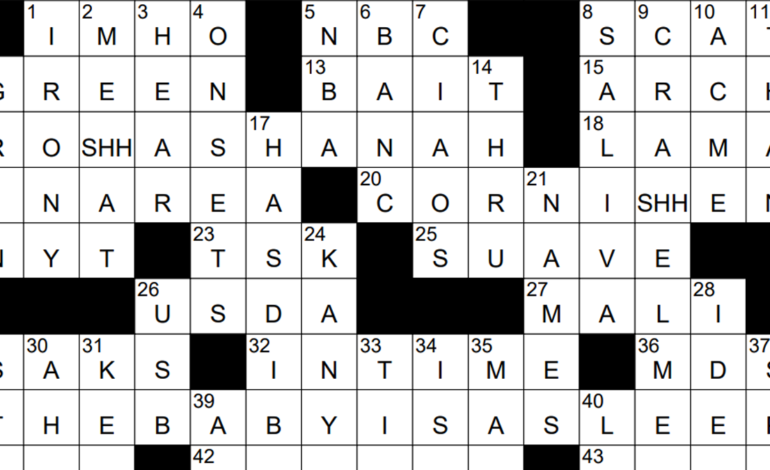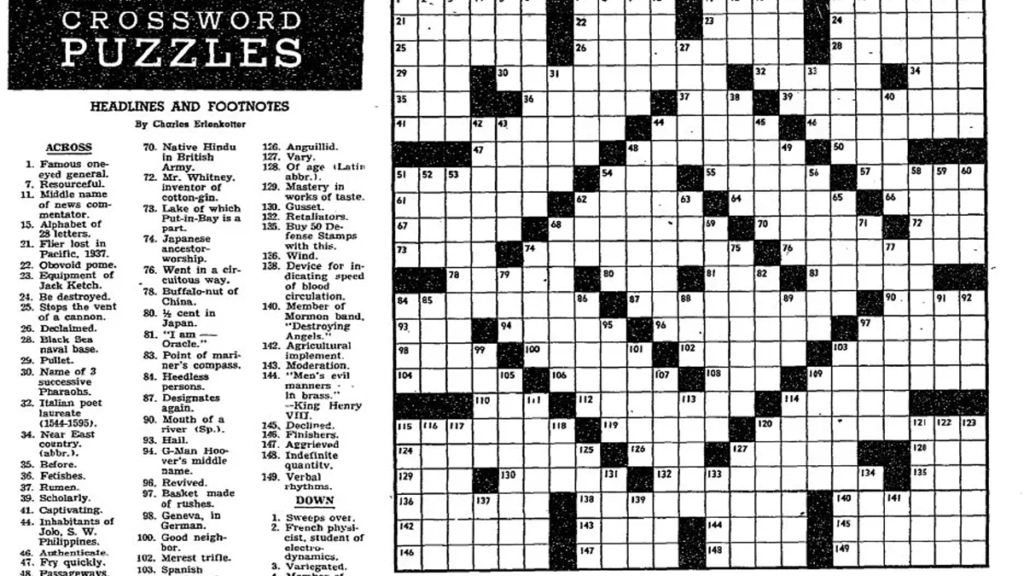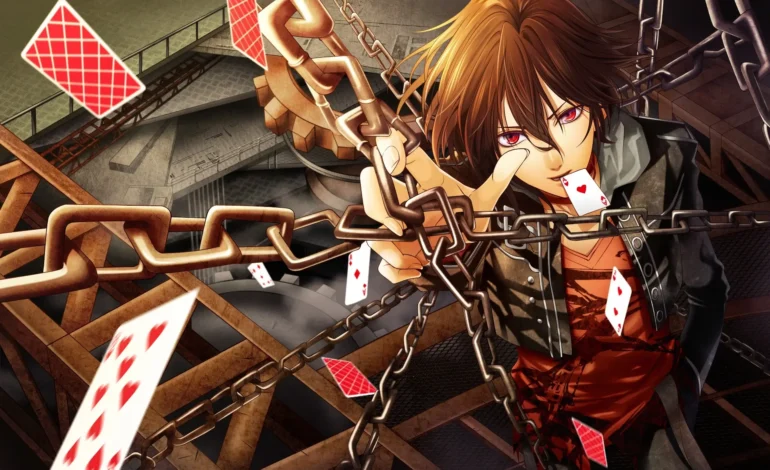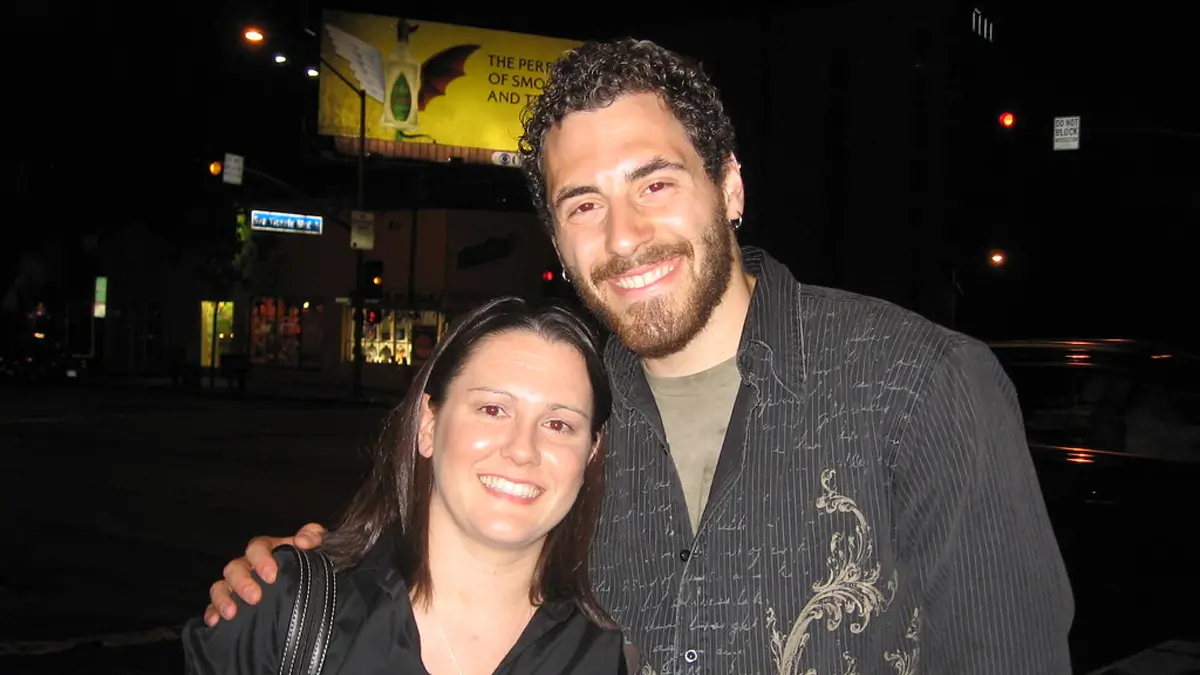Unlocking Success: Strategies for Sector NYT Crossword Puzzle Mastery

Are you surprised to the point of thinking that, indeed, you can handle the task of Sector NYT crossword puzzle challenges? Now, if these head-scratching clues have started to stump you and you think you may never get the clue, you needn’t be defeated! This instant guide will navigate you through the Sector NYT Crossword world and discover for you the secrets whose application will be your gate pass to victory. From beginner to masters – these are the PROVEN techniques to help you succeed and be the greatest crossword puzzle solver NYT Sector has to offer.
Understanding the Basics of Sector NYT Crossword Puzzles
Introduction to Sector NYT Crossword Puzzles:
This part of the article explains the main idea of the Sector NYT Crossword puzzles and the reason they are well-liked by the albums of romance music lovers. The module commences by illustrating the specific features and difficulties that one might encounter during these miseries.
Grid Structure and Conventions:
In this paragraph, we will explain the basic C-shaped grid structure that has been used in Sector NYT Crossword puzzles since the beginning. It includes issues such as the way the squares are black, meticulous griding, and spacing regulation of the words.
Types of Clues:
This is the part where I describe the various types of clues that feature most prominently in NYT’s Sector Crossword puzzles. It provides a way for the reader to comprehend the various methods the clues can be revealed, for example, straight answers, open-ended or cryptic clues.
Developing a Systematic Approach
Scanning for Easy Wins:
Readers will also learn to work with a systematic approach to find solutions to puzzles. They should start with hints that are easy to resolve first. Through this approach, the book can help readers build their confidence by starting with the easier clues and then moving on to the more complex ones.
Tackling Across and Down Clues:
In this block, users will be directed on the most efficient way of approaching both acrostics and boxes within the puzzle line. There is an accent on the success of linking clues, one to another, in a smooth flow.
Building on Partial Answers:
In this, readers learn that the attributing of certain answers can open entire closures that they might have previously overlooked. It shows that there may be two or more letters intersecting, and by removing those ones, we can easily go through the harder clues.
Utilizing Crossword Databases
Researching Past Puzzles:
This point of the essay outlines different benefits of getting online archives of the previous NYT Crossword Sector. It makes the readers pay close attention to tragedies, clues, and the words that are used often in the story, thus improving their problem-solving skills.
Exploring Puzzle Archives:
It is anticipated that readers will be drawn to solving the crossword puzzles of Sector NYT for the sake of studying the rubric of the famous constructors and looking into underused puzzles. It supports the idea that one should use puzzles from various periods to make studying more interesting.
Leveraging Solver Tools:
This part of the article presents to you the many puzzle solver tools and apps that will help with puzzle completion. It brings to mind that manual solving should not be replaced by these tools, instead, they can help to point out stumbling blocks and prove what is true.
These explanations provide the reader with a detailed insight into every section about the main part, which makes Sector NYT Crosswords solvable.

Embracing the Power of Patterns
Recognizing Common Patterns:
Here, readers are shown how to see between the lines, so to speak. This ability to recognize the common patterns within the puzzle, such as word formation, letter combinations, or even thematic elements, is taught. The game draws a line that links them with the concept of pattern recognition that solves clues faster.
Identifying Repeated Themes:
Here, the participants discover the skill of recognizing the differences within the repeated themes and motifs in the sector of the newspaper column NYT crossword jigsaw puzzles. Recurring themes and wordplay are the compositional means that constructors turn into the readers by shaping their puzzles according to these methods to contribute to the ability to solve.
Applying Pattern Recognition Techniques:
About the readers, this is used in this section to guide them in using the pattern recognition technique to solve some puzzles. It makes them go over hints and clues in the way to look for where solutions are, later using the deductive method to check and compare possibilities.
Mastering Wordplay and Double Meanings
Deciphering Wordplay Clues:
This paragraph tackles the aspect of teaching readers critical thinking skills as they deal with the different types of clues usually scattered in the Sector NYT cryptic crossword. It will explore how to identify and see through puns, homophones, anagrams, and additional linguistic mind-boggling.
Understanding Double Meanings:
The audience can foster their own abilities to trace and interpret the double meaning in Times Crossword Wordsearch puzzles. These are examples of comprehending texts that can be ambiguous or metaphorical and, as a result, exercising the mind to delve deeper and think beyond.
Practicing Word Association:
Here, readers are encouraged to practice word association techniques to uncover hidden meanings and connections within clues. It emphasizes using synonyms, antonyms, and word relationships to expand problem-solving abilities.
Leveraging Context and Theme
Understanding Puzzle Context:
Here the readers are advised to use the semantic method to see that the apparent clues are hidden symbols and can be linked to each other. This method reinforces the use of paronyms, antonyms, and seeking word relations which will in turn extend thinking capabilities.
Exploring Thematic Elements:
It helps to know what it might mean in this puzzle. It leads them through knowledge of reading the clues related to the topic of the puzzle and how they can be utilized to arrive at one definite answer.
The acquisition of thematic elements will be presented in Sector NYT, the puzzle will be explored by readers. These ideas could revolve around recurrent elements like culture, references, and other motifs that help to uncover the mystery.
Using Theme-Based Strategies:
Here, what players could do to successfully use the puzzle is given. It involves, among others, using theme-based knowledge and then revealing how the thematic features can be utilized to easily set the record straight on thorny clues.
Enhancing Vocabulary Skills
Expanding Your Vocabulary:
Here is the part that emphasizes the fact that building an extensive vocabulary is indispensable if the readers want to be successful in the Sector NYT Crossword puzzles. In addition, it advises on a wide range of activities including deciphering the meanings of unfamiliar words, engaging in crosswords or puzzles, and using other available resources.
Learning Crossword-Specific Vocabulary:
Readers will find out that there is so much that comes along with crossword vocabulary on top of vocabulary as a whole. This includes learning the basis for popular crossword puzzle words and abbreviations, symbols, and the parlance of crossword puzzle games.
Incorporating New Words into Daily Usage:
The crossword is the part where they are now given an extra task of actually using the words they encounter in the game in their everyday vocabulary. This brings into focus the utility of practice in which one does not memorize but learns to use commonly heard words in a conversation or writing.
Harnessing the Art of Guessing
Making Educated Guesses:
In this portion, the reader learns to make a crossword puzzle even tougher by solving the hard words within it. It maximizes using situational language, pattern perception, and logical deductions to rule out possible choices or just to make risky decisions.
Embracing Trial and Error:
The players will be encouraged to make mistakes and get over them cleverly to complete a puzzle. It is about being creative, trying new paths, and improving approaches by listening to feedback, as well as mistakes, that will serve to improve strategies.
Overcoming Fear of Failure:
This is the part where the programmers advise to concentrate on education, not fearing failing, and take into account that the puzzles have a teaching purpose. It says that making mistakes is a normal part of being on the road toward mastering the challenges and also that persistence and resilience are what you need to finish the race.
Staying Calm Under Pressure
Maintaining Focus and Composure:
The part of this section drives home that one should keep his head down on the ground and not be in restless excitement, even during the hardest puzzles. This guide gives suggestions on how to keep cool-headed, not lose temper, and take each clue with memory.
Taking Breaks When Needed:
Readers will understand why they need to take a pause and relax a bit if they are feeling like they might be stressed or if they’ve been going over a certain clue for a long time without getting the answer. In this case, you go back to the puzzle and then take a while to become mentally clear and then return with perspicacity.
Practicing Mindfulness Techniques:
Here, people can learn the mindful approaches that will calm them and make their thinking process while solving puzzles clearer. It is full of strategies, including breathing techniques, visualization, and staying conscious about the present.
Practicing Consistency
Establishing a Routine:
This section is dedicated to giving instructions about the necessity of having a fixed practice for puzzles. It helps readers put some time into honing their skills. This time improves the tempo and inspires readers to take daily practice.
Setting Achievable Goals:
By the end of this guide, the readers can expect to highlight vital goals for their puzzle-solving. This includes nothing more than splitting the larger goals into bite-sized pieces and monitoring progress by comparing it to the starting point.
Exploring Collaborative Puzzling
Engaging with Puzzle Communities:
This point is calling for a joint engagement with either virtual or existing real-life puzzle communities. It reminds the players of these gains through interactivity, the exchange of clues, hints, and ideas among them, thereby allowing them to solve these puzzles collectively.
Participating in Puzzle Events:
Readers will be educated on the importance of participating in the competitions of puzzle mind games via the way of puzzling events. This would involve, for example, competing in crossword tournaments, participating in puzzle hunts, or solving online challenges. In this way, I grow skills and connect with other crazy people.
Organizing Puzzle-Solving Sessions:
In this, attendants are instructed to facilitate game-play sessions among friends, relatives, and colleagues. These are a basis for teamwork, creativity, and comradery as learners from one another also help them work together and test their ingenuity.
Adapting to Changes in Puzzle Trends
Staying Updated on Puzzle Trends:
This part of the guide stresses the significance of being up to date with upcoming mystery designs, methods, as well as solving techniques. It promotes readers by recommending frequent investigation of diverse puzzles, problem types, and innovative designs to adjust their solutions to these.
Flexibility in Solving Approaches:
Readers are to discover multiple ways to manipulate the same problem and a large toolkit of various techniques. This entails being adept at applying different approaches, trying new techniques, and adjusting the methodology in line with the shadows in the organizational person’s multi-rated approach and challenges.
Embracing Innovation and Creativity:
Here, we invite you to discover the boundless possibilities of these puzzles and to be co-creators of potential solutions. This means of reaching the solution building involves thinking unpredictably, being open to atypical ways, and crossing traditional borders.
Seeking Inspiration from Puzzle Masters
Studying the Work of Puzzle Masters:
This section challenges readers to research the work of leading puzzlers and problem solvers to better understand how solutions are constructed. It brings together the importance of studying their line thinking, flow, and signature marks to find commonalities and acquire techniques for solving puzzles better.
Attending Puzzle Workshops or Lectures:
In these workshops or lectures, attendees will be taught and enjoy the perks of tackling puzzles arranged by puzzle masters, which boosts their engagement. This enables the exchange of information directly with the mentors, asking questions, and gaining valuable knowledge into higher level skills necessary to solve complex problems.
Engaging with Puzzle Masters Online:
Here, the readers will find that the developers have mentioned platforms like online forums and social media for communicating with puzzle masters to make processes easier. This provides the opportunity for the participants to communicate, even brainstorm ways of solving the puzzles, and also get a personal touch from the experts.
Celebrating Milestones and Progress
Recognizing Achievements:
This part doesn’t underline the significance of acknowledging and awarding celebrations for all the jigsaw puzzle-solving actions, whether big or small. It is a celebration of the effort and pleasure that the reader can have when he or she considers every step to be an important achievement and a step toward mastery.
Setting Reward Systems:
The readers will discover one benefit of the gamification strategy which is rewarding the players based on the progress they have made in solving the puzzle One can also reward him/her self for example treating him/her with light incentives upon coping with the puzzles, reaching the goals, or becoming proficient with different techniques of solving.
Cultivating a Positive Mindset:
Through these three steps, the task is really to develop a good puzzle-solving attitude. It requires acquiring life skills like being willing to face difficulties, finding answers in unexpected places, and staying both positive and enthusiastic when running out of ideas.
Embracing the Joy of Solving
Finding Joy in the Process:
By promoting a deeper appreciation of the process of solving puzzles rather than simply concentrating on the end outcome this part makes the readers ask for some joy in puzzling. If solving a mystery is as good as the feeling of figuring out a puzzle or the fun of traveling in space makes one feel the same way then what is the thrill of investigating a mystery?
Connecting with the Puzzle Community:
Readers will discover the unity that comes with participating in the larger puzzle-solving community. Through my strategy, readers will recognize that there is always a friendly community, ready to help and support each other on the road to greater personal fulfillment. This community provides us with the opportunity to share our stories, give some tips, and a lot more together with fellow enthusiasts whom we probably don’t know, to celebrate our mutual achievements.
Exploring New Challenges:
Here, puzzlers are not only provided words of encouragement about fun but also challenged on the possible boundaries of their brain skills in solving puzzles. It means looking for the maze of different puzzles by their level of difficulty, groove, and designs to expel the monotony from becoming the everyday.
Conclusion
You now have sound tactics in your pockets; you are therefore prepared to start your magical walk to winning at level NYT crossword puzzles. Whether you are taking on this challenge by yourself or if you need the help of other willing puzzle solvers, tackle each challenge with self-belief, inquisitiveness, and a spirit of adventure. Gradually taking it easy, showing some tolerance and continuous efforts, you’ll crack the code in your head and find out the full intended meaning of Sector Crossword puzzles.




